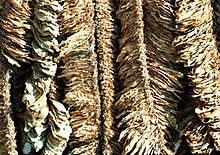Cultivation of tobacco
| Part of a series on |
| Tobacco |
|---|
 |
Tobacco is usually cultivated annually. It is grown from cold frames or hotbeds and then translated to the field until it matures. Tobacco is grown in warm climates with rich, well-drained soil.
Sowing

Tobacco seeds are scattered onto the surface of the soil, as their germination is activated by light. In colonial Virginia, seedbeds were fertilized with wood ash or animal manure (frequently powdered horse manure). Seedbeds were then covered with branches to protect the young plants from frost damage, and the plants were left alone until around April.
In the 19th century, young plants came under increasing attack from certain types of flea beetles, Epitrix cucumeris or Epitrix pubescens, which caused destruction of half the tobacco crops in United States in 1876. In the years afterward, many experiments were attempted and discussed to control the flea beetle. By 1880 it was discovered that replacing the branches with a frame covered by thin fabric would effectively protect plants from the beetle. This practice spread until it became ubiquitous in the 1890s.
Today, in the United States, unlike other countries, tobacco is often fertilized with the mineral apatite in order to partially starve the plant for nitrogen, which changes the taste. This (together with the use of licorice and other additives) accounts for the different flavor of American cigarettes from those available in other countries. There is, however, some suggestion that this may have adverse health effects attributable to the content of apatite[citation needed].
Transplanting
After the plants have reached a certain height, they are transplanted into fields. This was originally done by making a relatively large hole in the tilled earth with a tobacco peg, then placing the small plant in the hole. Various mechanical tobacco planters were invented throughout the late 19th and early 20th century to automate this process, making a hole, fertilizing it, and guiding a plant into the hole with one motion.
Harvest

Tobacco can be harvested in several ways. In the oldest method, the entire plant is harvested at once by cutting off the stalk at the ground with a sickle. In the nineteenth century, bright tobacco began to be harvested by pulling individual leaves off the stalk as they ripened. The leaves ripen from the ground upwards, so a field of tobacco may go through several so-called "pullings," more commonly known as topping (topping always refers to the removal of the tobacco flower before the leaves are systematically removed and, eventually, entirely harvested. The stalks are left as compost to postpone over-farming and thus soil lacking essential nutrients for a strong crop the following year. "Cropping," "Topping," "Pulling", and "Priming" are terms for removing mature leaves from tobacco crops. Leaves are cropped as they ripen, from the bottom to the top of the stalk. The first crop of leaves located near the base of the tobacco stalk are called "sand lugs" in more rural southern tobacco states. They are called "sand lugs" because these leaves are close to the ground and get splashed with sand and clay when heavy rains hit the soil. Sand lugs weigh the most, and are most difficult to work with. Their weight is due to their large size and the added weight of caked-on soil; slaves would "lug" each stack to the stringer, a typically female slave who bundled each stack of leaves. Eventually workers carried the tobacco and placed it on sleds or trailers. As the industrial revolution approached America, the harvesting wagons used to transport leaves were equipped with man powered stringers, an apparatus which used twine to attach leaves onto a poll. In modern times large fields are harvested by a single piece of farm equipment, although topping the flower and in some cases the plucking of immature leaves is still done by hand.
Some farmers still use "tobacco harvesters." They are not very efficient yet highly cost effective for harvesting premium and rare strains of tobacco. The harvester trailers for in-demand crops are now pulled by gasoline fueled tractors. The croppers pull the leaves off in handfulls and pass these to the "stringer", which bundles the leaves to a four-sided pole with twine. These poles are hung until the harvester is full. The poles are then placed in a much larger wagon to be pulled by modern farm tractors to their destination. For rare tobaccos they are often cured on the farm. Traditionally, the slaves who cropped and pulled had a particularly tough time with the first pull of the large, dirty, base leaves. The leaves slapped their faces and dark tobacco sap which dries into a pitch black tar covered their bodies, and then soil stuck to the tar. There was one perk however: nicotine in tobacco acts as a powerful insecticide. Slaves could enjoy a bug free day of forced labor when harvesting tobacco. The croppers were men, and the stringers, who were seated on the higher elevated seats, were women and children. The harvesters had places for one team of ten workers: eight people cropping and stringing, plus a packer who moved the heavy strung poles of wet green tobacco from the stringers and packed them onto the pallet section of the harvester, plus a horseman. Interestingly, the outer seats were suspended from the harvester - slung out over to fit into the aisles of tobacco. As these seats were suspended it was important to balance the weight of the two outside teams (similar to a playground see-saw). Having too heavy or light a person in an unbalanced combination often resulted in the harvester tipping over especially when turning around at the end of a lane. Water tanks were a common feature on the harvester due to heat, and danger of dehydration.
See also
References
Notes
Bibliography
- "tobacco: Cultivation and Curing - Infoplease.com". Infoplease.com. 2007. Retrieved 2008-08-22.
{{cite web}}: Cite has empty unknown parameters:|accessdaymonth=,|month=,|accessyear=,|accessmonthday=, and|coauthors=(help)
